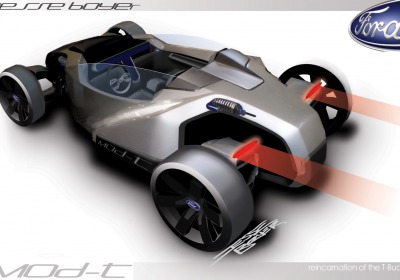CCS Ford Model T project
Fri, 13 Jun 2008This past semester, eleven junior-level College for Creative Studies (CCS) Transportation Design students were asked to reinterpret an automotive icon: the Ford Model T. Over the course of the 16-week semester the students created 11 different concepts for a Model T for the future without forgetting the underlying principle - creating an icon that would have equal significance and social impact like the 100 year old original.
On April 30 each of the students presented their research, sketches, renderings and one- quarter scale models judged by Peter Horbury, Ford Executive Director of Design, The Americas and Pat Schiavone, Ford's Design Director for North America Trucks and CUVs. The winning concept, which the judges thought best embodied the spirit, innovation and sociological impact equal to that of the original Model T, was created by Dong Tran, of Cicero, New York.
Dong Tran
Inspired by nature, architecture and man-made objects, Tran's concept took on a functional design approach infused with an efficient and simple surface language. Every form of the vehicle is to have a practical purpose in manufacturing techniques, costs and materials choice. The Model T of 2030 is a vehicle that will appeal to a global market and be customizable to specific markets as well as its origin in the United States. It will be the livelihood of some and purely recreational to others. Whatever the purpose might be, it will be a vehicle that is responsible and self sustainable from cradle to cradle.
Filip Bosevski
This modern Model T interpretation is an urban/camping vehicle that embodies the original Model T's social significance functionality and versatility inspired by frame structures like camping tents for example. Featuring a detachable interchangeable tent frame that integrates into the body the concept could be used for multiple purposes. The new Model T is also a fashion statement. Customers that want to stand out from the crowd could customize the look of their Model T to their personal taste right from their home thanks to the easily detachable body panels.
Jesse Boyer
The project had many ways that it could be approached. Boyer took the unconventional approach to the design with a project based on the after-production life of the Model T. Influenced by the emotional connection that Boyer had with the T-bucket (the 50's Hot-Rods that used the T body, stripped it down and wedged in a large engine), his concept focuses on the modularity, flexibility, and lightweight nature of the Model T. The main idea is to redesign a T-bucket for future Hot-Rodders while pushing it into the future with technology and abandoning gas powered engines all together. The car is called the MOD-T.
Hyeoksang Chung
Using the aspect of memory for the original Model T's 100 Anniversary Chung developed a concept that is a celebration of the customer and Ford: an open-wheel and off-road concept with a sleek interior design. Only 100 of this limited edition vehicle would be produced. Chung also interpreted all segments of the original Model T for the revitalized concept, taking into consideration the headlamps, hood, and other design features to develop a primitive shape with a creative exterior design. This concept will appeal to wealthy consumers that are nostalgic for the original Model T.
John (Jody) Ingle
The vision that Henry Ford had was to create a vehicle that could be affordable to the masses. One that was so easy to drive even child could operate, and so durable that it could traverse any terrain or complete any task. Ingle's objective was to create a vehicle that stood up to the ideals of the Model T: simplicity, flexibility, and efficiency. Through the application of these attributes, the standardization of a revolutionary idea was achieved. According to Ingle, the future of automobiles lies in autonomous capabilities and mobile communication technology.
Continues →
By

